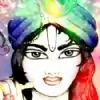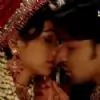The manifested world of plurality has emerged from the unmanifest Reality. To indicate this Brahma the creator is described as being born from the navel of Vishnu as he is lying on the great serpent, Ananta in the milky ocean.
One of the earliest iconographic descriptions of Brahma is that of the four-faced god seated on a lotus. The Lord has in his four hands a water-pot (kamandalu), a manuscript (Vedas), a sacrificial implement (sruva) and a rosary (mala). He wears the hide of a black antelope and his vehicle is a swan {hamsa).
The description of Brahma like those of other deities of Hinduism bears a mystic symbolism. The lotus represents the Reality. Brahma sitting on the lotus indicates that he is ever-rooted in the infinite Reality. Reality is the foundation on which his personality rests. The four faces of Brahma represent the four Vedas. They also symbolise the functioning of the inner personality (antahkarana) which consists of thoughts. They are the mind (manas), the intellect (buddhi), ego (ahamkara) and conditioned-consciousness (chitta). They represent the four ways in which thoughts function. They are the manifestations of the unmanifest Consciousness.
The animal hide worn by Brahma stands for austerity. A seeker who desires to realise his godhead must first go through spiritual disciplines. Observing such austerities the seeker must carefully study and reflect upon the scriptural truths which are suggested by the manuscript (Vedas) held in one hand. Having acquired the knowledge of scriptures he must work in the world without ego and egocentric desires, that is engage in dedicated and sacrificial service for the welfare of the world. This idea is suggested by the sacrificial implement held in the second hand. When a man works in the world selflessly he drops his desires. He is no longer extroverted, materialistic, sensual. His mind is withdrawn from its preoccupations with the world of objects and beings. Such a mind is said to be in uparati. A man who has reached the state of uparati is in a spirit of renunciation.
That is indicated by Brahma holding the kamandalu in his hand. Kamandalu is a water-pot used by a sanyasi-a man of renunciation. It is a symbol of sanyasa or renunciation. The mind of such a man which is withdrawn from the heat of passion of the world is available for deeper concentration and meditation. The rosary (mala) in the fourth hand is meant to be used for chanting and meditation. Meditation is the final gateway to Realisation. Through deep and consistent meditation the mind gets annihilated and the seeker attains godhood. A god-man maintains his identity with his supreme Self while he is engaged in the world of perceptions, emotions and thoughts. He retains the concept of unity in diversity. He separates the pure unconditioned consciousness underlying this conditioned world of names and forms. Brahma's association with a swan is most appropriate in this context.
A swan is described in Hindu mysticism as possessing the unique faculty of separating pure milk from a mixture of milk and water. It is reputed to have the ability to draw the milk alone and leave the water behind. Similarly does a man of Realization move about in the world recognizing the one divinity in the pluralistic phenomena of the world.
Brahma is said to be the Lord of creation. The creator must necessarily possess the knowledge to create. Without knowledge no creation is possible. Hence Brahma is said to be wedded to the goddess of knowledge, Saraswati. Life in this world is a manifestation of the three principles of creation, sustenance and destruction. In fact these three are interconnected. The apparent destruction is only an essential forerunner to creation.
Destruction and creation go hand in hand. They are like two sides of a coin. For example, the destruction of morning is creation of noon and the destruction of noon is creation of night. This chain of continuous destruction and construction maintains the day. Similarly, the destruction of childhood is the creation of youth and the destruction of youth the creation of old age. In this process of birth and death the individual is maintained. Hence the three gods of the Trinity viz. Brahma, Vishnu and Siva representing creation, maintenance and destruction, are essentially one and the same.
The above idea is well portrayed in Lord Dattatreya, in whose form the three gods are combined. Dattatreya has the three faces of Brahma, Vishnu and Siva to indicate that the three principles for which they stand are inseparable. Lord Dattatreya is shown with four dogs following him. The four dogs represent the four Vedas. A dog is one of the most faithful animals in the world and it follows its master in all environments and circumstances. So, too, the Vedas arc said to follow a man-of-Realisation in the sense that all his actions, thoughts and desires are in perfect accord with the principles enunciated in the Vedic textbooks.
All creations arise out of vikshepa (thought disturbances). This vikshepa-sakti is Lord Brahma-the total mind-intellect equipment. Man, being essentially constituted of his mind and intellect, has already invoked this vikshepasakti and realised Brahma. Hence the worship and invocation of Brahma is practised by few.
Yet there are a few shrines dedicated to Brahma. He is worshipped and invoked particularly by scientists and kings for generating more creative ideas to serve the world of men and matter. The rulers invoke the Lord in order to surrender their ego and produce plans and schemes to serve the nation. Similarly, the research scholars invoke creative inspiration and flashes of new thoughts revealing the secrets of nature.
Lord Brahma is not popularly worshipped in India. This is so, because the idea of creation is repugnant to seeker of Truth since the creation of thoughts has veiled the infinite Reality. The attempt of all spiritual seekers is to destroy the existing thoughts and maintain the state of single pointed thought until the Reality is revealed. Hence, Siva (god of destruction) and Vishnu (god of maintenance) are worshipped more than Brahma. In fact, there are very few temples of Brahma-one in Rajasthan and another in Orissa -compared to innumerable shrines of Siva and Vishnu existing all over India
|
Lord Vishnu, major god of Hinduism and Indian mythology, popularly regarded as the preserver of the universe. In the ancient body of literature called the Veda, the sacred literature of the Aryan invaders, Vishnu ranks with the numerous lesser gods and is usually associated with the major Vedic god Indra in battles against demonic forces. In the epics and Puranas-writings belonging to subsequent periods in the development of Hinduism-Vishnu (especially in his incarnations) becomes prominent. Some Puranic literature refers to him as the eternal, all-pervading spirit and associates him with the primeval waters believed to have been omnipresent before the creation of the world. So regarded, Vishnu is depicted frequently in human form, sleeping on the great serpent Shesha and floating on the waters. The concept of Lord Vishnu as preserver is comparatively late. It is based chiefly on two beliefs: humans may attain salvation by faithfully following predetermined paths of duty, and good and evil powers (gods and demons) contend for dominion over the world. Occasionally, the balance of power is upset in favor of evil, and then Lord Vishnu is believed to descend to earth in a mortal form (his avatar) to save humankind or the world. |  | |
Lord Vishnu is depicted as dark blue or black (his avatars appear in other colors). Normally, he is depicted with four arms: One hand holds a lotus; a second holds a conch; a third holds a discus (which always returns by itself after being thrown); and the fourth carries a mace. The petals of the lotus are believed to symbolize the unfolding of creation; the conch is said to symbolize that from which all existence originates; and the discus and the mace reputedly were obtained by Lord Vishnu as rewards for defeating the God Indra. Lord Vishnu is said to possess also a special sword called Nadaka and a special bow called Sarnga. His wife is Goddess Lakshmi (also known as Shri), goddess of beauty and fortune. He rides a huge creature, half bird and half man, called Gandara. His home is in a heaven called Vaikuntha (where the Ganges River is believed to flow from its source at Vishnu's feet). The god has a thousand names, the repetition of which is regarded as an act of devotion. |
| Shiva is one of the gods of the Trinity. He is said to be the god of destruction. The other two gods are Brahma, the god of creation and Vishnu, the god of maintenance. The three gods represent the three fundamental powers of nature which are manifest in the world viz. creation, destruction and maintenance. These powers exist perpetually. Creation is going on all the time. So is destruction and maintenance. All three powers are manifest at all times. They are inseparable. Creation and destruction are like two sides of a coin. And maintenance is an integral part of the processes of creation and destruction. For example, morning dies to give birth to noon. Noon dies when night is born. In this chain of birth and death the day is maintained. To indicate that these three processes are one and the same the three gods are combined in one form of Lord Dattatreya. Lord Dattatreya has the faces of Brahma, Vishnu and Shiva. Shiva is married to the Goddess Uma. Uma represents frakriti which means perishable matter. Shiva's marriage with Uma signifies that the power of destruction has no meaning without its association with perishable matter. Destruction manifests itself only when there is perishable matter. Lord Shiva sits in a meditative pose against the white background of the snow-capped Himalayas in Mount Kailas. His posture symbolises perfect inner harmony and poise, experienced by a man of Realisation. He is rooted in God- consciousness. He revels in the bliss of the transcendental Reality. Nothing disturbs him. The vicissitudes of nature, the challenges of life, the trials and tribulations of the terrestrial world do not affect him at all. He maintains perfect serenity, equanimity and tranquility in all environments and circumstances. |
The snow-white background symbolises the absolute purity of mind. When the mind is disturbed, agitated, you do not see the divinity in you. Recognising your divine self is like seeing a reflection in a pool of water. When the water is dirty or disturbed you cannot see your own reflection. Only when the water is clear and steady do you recognize your reflection. Similarly, the divinity in you is lost in a pool of thoughts. If the thoughts are dirty (tamasic) or agitated (rajasic) you miss your divine Self. By spiritual practices you ought to raise your personality from its tamasic and rajasic states to the state, of sattwa. In the sattviic state when the mind is absolutely pure and steady you recognise your supreme Self. That is the state of Shiva in Kaila
On the auspicious occasion of MahaShivaratri, Shiva performs the ecstatic dance of realisation. In the dance pose Shiva is known as Nataraja. The dance symbolises the thrill of god-realisation. Beyond the realms of the waking, dream and deep-sleep states of consciousness. Beyond the ' experiences of the body and its perceptions, the mind and its feelings, the intellect and its thoughts lies the bliss of Godhood. Shiva reaches this state of Godhood and dances with the intoxication of supreme bliss
Shiva is said to have a third eye known as gyana chakshu. Gyana chakshu literally means eye of wisdom. The eye whose vision reaches beyond that of the two mortal eyes. The idea of the third eye is not to be taken literally to mean that a third fleshy organ exists in Shiva. It only means that Shiva has a divine vision of Reality. Your vision is confined merely to perceptions, emotions and thoughts but when you transcend the limitations of your body, mind and intellect you gain realisation of your inner Self. That is indicated by the opening of the gyana chakshu
Shiva us also known as "Gangadhar", Gangadhar literally means the carrier of Ganga (River Ganges). Shiva is said to carry the Ganges in his locks. Shiva is sometimes shown with his trident ("trishool") in his hand. The "trishool" is a three pronged weapon which symbolizes the destruction of the ego with its three-fold desires of the body, mind and intellect. Shiva with his weapon indicated his victory over his ego and attainment of the state of perfection. |


























